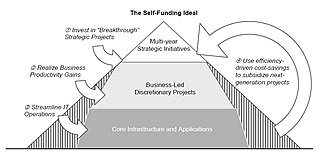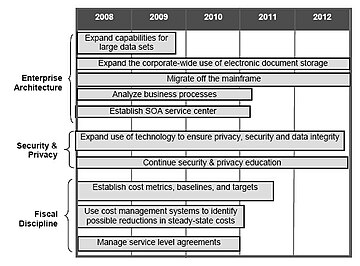| Revision as of 20:15, 11 January 2011 editWill20036 (talk | contribs)10 edits →Overview← Previous edit | Revision as of 20:17, 11 January 2011 edit undoWill20036 (talk | contribs)10 edits →HistoryTag: references removedNext edit → | ||
| Line 6: | Line 6: | ||
| == History == | == History == | ||
| The information previously contained in this section is more appropriate for a topic related to the federal government's enterprise architecture. | |||
| Historically, Federal agencies have managed IT investments autonomously. Until the new millennium, there has been little incentive for agencies to partner to effectively reuse IT investments, share IT knowledge, and explore joint solutions. A collective, government-wide effort, supported by the Federal CIO Council, utilizing the ] (FEA), has been undertaken in an effort to yield significant improvements in the management and reuse of IT investments, while improving services to citizens, and facilitating business relationships internally and externally. The FEA is a business-based framework that provides the Office of Management and Budget (OMB) and Federal agencies a way to monitor, analyze, and control Federal IT investments.<ref>FDIC (2003). '''' </ref> The ] first realized the value of EA in 1997, when two business executives had to reconcile data that had come from different systems for a high-profile report to the banking industry. The FDIC's first EA blueprint was published in December 2002.<ref>Gregg Kreizman, Cathleen E. Blanton (2005) "" Gartner, Inc.</ref> | |||
| The information referring to the FDIC's enterprise architecture is out-of-date and inaccurate. | |||
| In 2004 the Federal Deposit Insurance Corporation (FDIC) recently received a 2004 Enterprise Architecture Excellence Award from the Zachman Institute for Framework Advancement (ZIFA) for its initiative to manage corporate data collaboratively. ], an expert on enterprise architecture, founded ZIFA, a network of information professionals supporting enterprise architecture's role in helping organizations operate from a corporate perspective.<ref></ref> | |||
| == EA framework topics == | == EA framework topics == | ||
Revision as of 20:17, 11 January 2011

FDIC Enterprise Architecture Framework is the Enterprise Architecture framework of the Federal Deposit Insurance Corporation (FDIC).
Overview
The information contained under this topic is outdated and no longer reflects the enterprise architecture of the FDIC. Please visit www.fdic.gov for more current information.
History
The information previously contained in this section is more appropriate for a topic related to the federal government's enterprise architecture.
The information referring to the FDIC's enterprise architecture is out-of-date and inaccurate.
EA framework topics
FDIC EA framework
The FDIC EA framework includes five components.
- Business Architecture : The Business Architecture describes the activities and processes performed by the Corporation to achieve its mission and to realize its vision and goals. Developing the Business Architecture is the first step in creating an Enterprise Architecture (EA) that links the Corporation's business needs to its Information Technology (IT) environment. Maximizing IT support for these requirements will optimize Corporate performance.
- Data Architecture : The Data Architecture describes the activities required to obtain and maintain data that supports the information needed by the Corporation’s major business areas. Data and information are different. Data is the foundation of information. Data is the raw material that is processed and refined to generate information. Information consists of a collection of related data that has been processed into a form that is meaningful to the recipient.
- Applications Architecture : The Applications Architecture describes the major types of applications that manage data to produce the information needed to support the activities of the Corporation. The Applications Architecture provides a framework that enables the migration from the current applications catalog and software development environment to the target integrated applications, development and engineering environments. The target architecture promotes the use of commercial and government off-the-shelf products, consolidating applications, where applicable, and the use of emerging technologies where appropriate.
- Technical Infrastructure Architecture : The IT infrastructure provides access to application systems and office automation tools used in performance of the business processes. The Corporation places high priority on maintaining a consistent, available, and reliable technical infrastructure. The Technical Architecture describes the underlying technology for the Corporation's business, data, and application processing. It includes the technologies used for communications, data storage, application processing, and computing platforms.
- Security Architecture : The Security Architecture establishes a framework for integrating safeguards into all layers of the FDIC's Enterprise Architecture. The security architecture uses a risk management and information assurance strategy that provides access control, confidentiality, integrity, and non-repudiation for the Corporation's information and systems.
Future IT Development

The banking business model has become more complex, giving rise to financial instruments such as collateralized debt obligations (CDOs) and structured investment vehicles (SIVs) to manage risk. These instruments have created greater dependencies between the domestic and international financial markets. Financial institutions must, therefore, strike a balance between regulatory, legislative and banker concerns while appropriately managing risk.
As cost savings are realized from a simplified IT environment and more efficient processes, the savings will be reinvested for IT improvements or accrue to the Corporation. This self-funding model is shown on the right.
Five-Year Technology Roadmap
The technology roadmap outlines the major initiatives for standardizing the IT environment and increasing IT’s efficiency and effectiveness over the next five years. The initiatives were determined by various sources including business-side IT roadmaps, executive management planning meetings, client planning sessions, and client year-end reviews. The three major initiatives identified are enterprise architecture, security and privacy programs, and fiscal discipline.

The enterprise architecture initiative will focus on simplifying the environment to ensure stable and economical performance for mission-critical applications. Simplifying the environment to decrease costs will include activities, such as decreasing the number of application systems and migrating applications off the mainframe. Efficiencies will also be gained by expanding capabilities for manipulating large data sets and storing traditional paper-based files electronically. The SOA service center will manage code (or services) for all development teams to discover and use, which will save time and costs in application development, testing and deployment.
The Corporation will continue to enhance IT security and privacy programs to address new and evolving risks by improving controls over sensitive data. In some cases, technology, such as scanning outgoing e-mail for sensitive information and encrypting removable storage devices, can mitigate potential risks. The other cornerstone of mitigating risk is educating employees of emerging security and privacy issues.
Lastly, in order to continue sound fiscal discipline and responsibility, the Corporation will establish IT baselines and metrics, study steady-state costs, manage service level agreements, and more judiciously choose new development projects. These three areas – enterprise architecture, security and privacy programs, and fiscal discipline – are shown below with the estimated time frames.
See also
References
- OIG (2005). Implementation of E-Government Principles. May 2005
- ^ Cite error: The named reference
FDICOIG05was invoked but never defined (see the help page). - ^ CIO Council (2008) Information Technology Strategic Plan 2008–2013, January 23, 2008.
Further reading
- Pallab Saha (2007). Handbook of Enterprise Systems Architecture in Practice. Chapter IX gives a detailed case study of the FDIC.
External links
- FDIC Homepage.